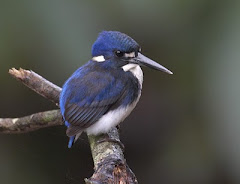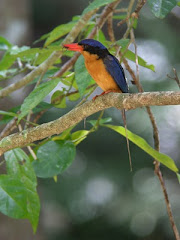Winter is the best time for seeing Monarchs in the coastal lowlands of the Daintree. The most common is Spectacled Monarch who can be seen and heard easily in many habitats. They are very active chasing insects and will often be seen with other insect eaters such as Little Shrike-Thrush. They love to bathe in birdbaths in domestic gardens.
The Pied Monarch is one of the Wet Tropics' 12 endemics and is found in both the lowlands and the upland areas of the Cairns Highlands. It is also easier to see in winter as a rule.The distinctive habit of running up, down and around tree trunks searching for food, plus the distinctive markings, make identification easy.
Both these birds have been in the gardens of Red Mill house in Daintree Village in the past few days.
Saturday, June 26, 2010
Monday, June 7, 2010
Winter Magic
Glorious weather in Daintree, making it the perfect time of year to visit. Lots of campervans and caravans about as winter descends on Southern Australia, but we still have 27 degree days and start complaining if the night-time temperature drops below 17 degrees.
Some great winter birds about with flycatchers, monarchs and fantails being more obvious foraging for insects in the morning and late afternoon light. Spotted Catbird and Victoria's Riflebird (female) are also easier to see at this time of year. A favourite, Lovely Fairy-Wren, is also reasonably easily seen along Stewart Creek Rd - a family group of five, including one gloriously coloured male.
The Blue Quandong fruit are maturing up, making great food for the Wompoo Fruit-Dove. Despite being remarkable colouful with it's purple breast and gold flashes on the wings, the Wompoo has the ability to disappear into the foliage. A beautiful bird, particularly when you catch it in the sunlight.
Some great winter birds about with flycatchers, monarchs and fantails being more obvious foraging for insects in the morning and late afternoon light. Spotted Catbird and Victoria's Riflebird (female) are also easier to see at this time of year. A favourite, Lovely Fairy-Wren, is also reasonably easily seen along Stewart Creek Rd - a family group of five, including one gloriously coloured male.
The Blue Quandong fruit are maturing up, making great food for the Wompoo Fruit-Dove. Despite being remarkable colouful with it's purple breast and gold flashes on the wings, the Wompoo has the ability to disappear into the foliage. A beautiful bird, particularly when you catch it in the sunlight.
Subscribe to:
Comments (Atom)





